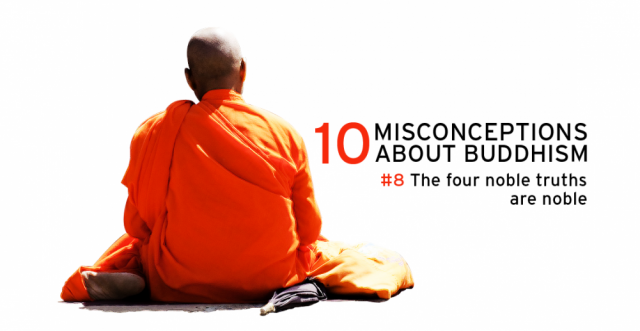
[This article is part of the 10 Misconceptions about Buddhism series]
The four noble truths—that existence is suffering (duhkha), that suffering has an origin (samudaya), that there is a state of the cessation (nirodha) of suffering, and that there is a path (marga) leading to that state of cessation—is the most famous of all Buddhist doctrines. It is the first thing that the Buddha taught—the content of his first sermon, or in the language of the tradition, what he explained when he first “turned the wheel of the dharma” (dharmacakrapravartana)—after concluding that the enlightenment he experienced under the Bodhi tree could be comprehended by others.
The “four noble truths” is the one phrase that most people know from Buddhism, the one thing they remember from their “Introduction to World Religions” course. Unfortunately, it is a mistranslation.
Related: 10 Misconceptions about Buddhism
The key term is “noble.” The original Sanskrit term arya—adopted by the Nazis as the centerpiece of their racist ideology—was in ancient India an ethnic self-designation used by inhabitants of north India (whether they were invaders, migrants, or natives remains a topic of scholarly debate) to distinguish themselves from other inhabitants of the region. The Buddha reinterpreted the word, which means “noble” or “superior,” from an ethnic designation into a spiritual one, referring to those with an insight into reality superior to that of ordinary people.
It appears that arya became a technical term early on in the tradition, referring specifically to four stages on the path to nirvana, or more accurately, to those who have reached those stages: the four noble persons (aryapudgala).
The first of the four are the stream-enterers (srotaapanna), those who have had an initial insight into the nature of reality, such that they have destroyed all causes for future rebirth as an animal, ghost, or in the hells, and who are destined to enter nirvana in seven lifetimes or less.
The second are the once-returners (sakrdagamin), who have deepened that insight, such that they will only be reborn in our world, the sensuous realm (kamadhatu), once more.
The third are the never-returners (anagamin), who have deepened that insight further so that they will never be reborn in our world again, but will achieve nirvana in “pure abodes” (suddhavasa) at the upper reaches of the heavens of the realm of subtle materiality (rupadhatu).
The fourth type of noble person are the worthy ones or arhats, who have destroyed all causes for future rebirth and will never be reborn again, entering nirvana at death. The Buddha passed through all four of these stages on the night of his enlightenment, becoming an arhat.
Thus, the term that we know as the “four noble truths” should really be translated as the “four truths for the [spiritually] noble.” The truths themselves are not noble; the people who understand them are. And it is the understanding of these truths that makes them noble. Another translation might be the “four ennobling truths.”
Related: What’s So Noble About the Four Noble Truths?
There is an important teaching in this term: the four truths are not true for everyone. Anyone who has not achieved at least the level of stream-enterer is called an “ordinary person” or “common being” (prthagjana)—sometimes also called bala, meaning “childish” or “foolish.” We ordinary persons are foolish because we don’t know the truth.
Specifically, we don’t know that existence itself is suffering, that suffering has an origin, that suffering can be brought to an end, and that there is a path to that state of cessation. We may know it intellectually, we might know it well enough to list it correctly on the midterm, but this does not make us noble.
Only the person who has direct insight into the four truths is noble. And it is only for such people that the four truths are, in fact, true.
[This story was first published in 2014]
The post Four Ennobling Truths appeared first on Tricycle: The Buddhist Review.
from Buddhism for Beginners – Tricycle: The Buddhist Review
https://tricycle.org/trikedaily/four-noble-truths-misconceptions/
from https://tricycle.org
#buddhism
No comments:
Post a Comment